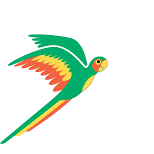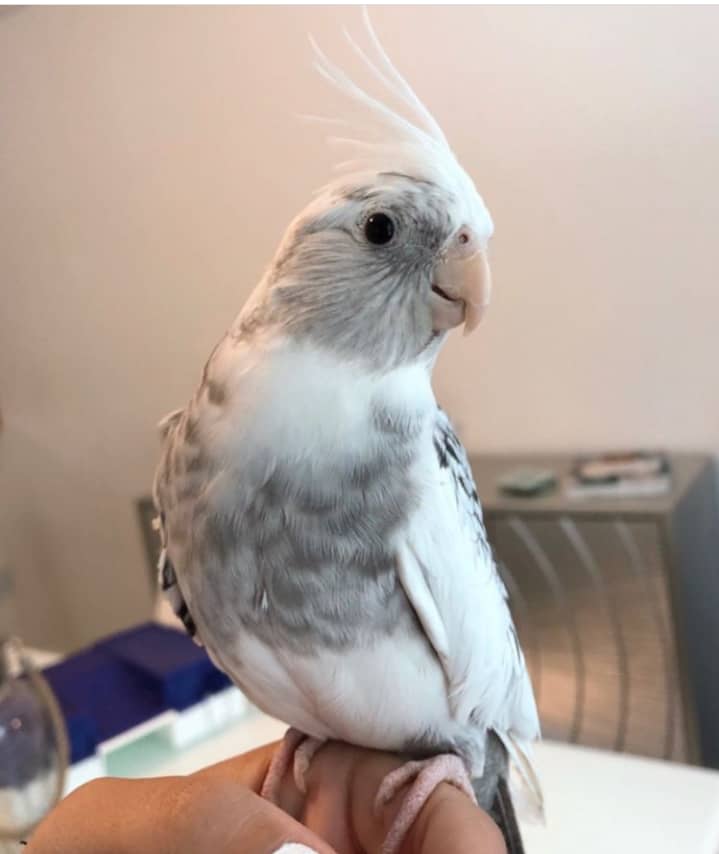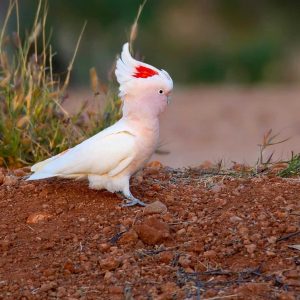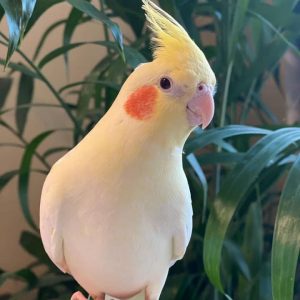Description
White Faced Cockatiel for sale
The White Faced Cockatiel for sale has a white or grayish face as shown above. This is a stunning cockatiel mutation, they stand out because they have no orange cheek patches or yellow coloring at all. The name of this mutation, derived from the male, is fairly self explanatory. The male is the most attractive of the two sexes with a brilliant contrasting white face. The female’s face, on the other hand, has a grayish coloration.
White-faced Cockatiels first appeared in 1964. Today they are fairly common mutations. Some very pretty White face varieties are created when combined with other cockatiel mutations and each of these mixes further enhances the beauty of these pet birds. Some of the different color varieties they come in include grey, pearl, cinnamon, pied, and albino. “L.A.” in the picture above looks like a Gray White face Cockatiel, or maybe a Pied Whiteface Cockatiel.
Cockatiels are probably the most popular of the parrot family with their main competition being the Budgerigar (referred to as the Parakeet in the United States). They are hardy, easily handle changes in their home, and are easy to breed. On top of that, keeping a cockatiel as a pet is easy because they are not noisy parrots and they are comfortable when left alone for long periods of time.
Cockatiel’s evolved as nomadic creatures, surviving in a variety of diverse and rugged habitats. They are constantly on the move, changing locations with the seasonal fluctuations of food and water supplies. This native habitat and their adaptive behavior has made them well suited as pets.
Care and feeding of White Faced Cockatiel
Bird Food:
A commercial cockatiel seed mix is generally regarded as suitable along with a good vitamin supplement. Pelleted diets will also provide a fairly balanced feed, however it does not contain the phytonutrients (antioxidant pigments) that are found in vegetables, fruits, grains, and seeds, so should be supplemented.
You can supplement your cockatiel’s diet with green foods such as dandelion leaves, weeds, carrot tops, celery, watercress, spinach, peas, seedling grasses, and millet. Various fruits will also be enjoyed such as apples, oranges, bananas and others.
Cuttlebones are recommended to help provide calcium and to help keep the beak trim. Proteins can be offered in the form of mynah pellets, game bird starter, dog food, and even mashed hard-boiled eggs.
Grit should not be provided.Parrots that eat seed whole without shelling it first require grit, but cockatiels shell their seed before eating it, so don’t need grit.
Water:
Give your cockatiel fresh drinking water every day. You can also add soluble vitamins and minerals to the water.
Bird Baths:
Your cockatiel will enjoy a bath! Bird baths can be either a dish in the bottom of the cage or a light misting with a spray bottle.
Bird Grooming:
Cockatiel care also includes grooming. It is important to keep their wings clipped. This will prevent your cockatiel from taking to the air and you never seeing it again. It also facilitates taming cockatiels. Fresh branches from trees and bushes such as oak, maple, and fruit trees will give hours of chewing and climbing pleasure while exercising and trimming the beak and nails.
Good cockatiel care will keep your bird healthy and active for years. Fresh food and water must be provided daily.
Social Behaviors
Cockatiels travel in flocks in the wild and this influences cockatiel behavior in captivity. Their social ‘flock’ disposition along with their native habitat makes them well suited as pets. They are hardy, adapt easily to change, and are easy to breed. They make a very loving and devoted pet if bonded properly.
White-Faced Cockatiels behave the same way like other cockatiel species. Cockatiels are generally sociable birds who enjoy spending time with their family and other cockatiels. They have a lot of energy and are quite playful.
Cockatiel parrots of the same sex that live in the same cage do well because they spend a long time getting to know each other.
If you don’t want your cockatiels to display any potential sectional behavior, acquire a new large-sized cage. The cage should be large enough to accommodate both cockatiel parrots.
Temperament
White-Faced Cockatiels behave similarly to other cockatiel species. Cockatiels are generally sociable birds who enjoy spending time with their family and other cockatiels.
They have a lot of energy and are very playful. They cannot communicate as well as most parrots, although they can learn a few tricks and gestures.
These birds can coexist peacefully with other Cockatiels if their cages are large enough for both of them. When comparing male and female aggression, the female is less aggressive. They will exit the cage and return without assaulting the owner.
Male white faced cockatiel for sale, on the other hand, are more likely to struggle and attack you.
Females are affectionate and like being petted. Because of this species’ sociable tendency, it’s preferable to obtain a second bird for companionship if you aren’t home much. They can be kind and sociable if properly socialized.
Speech and Vocalizations
Unlike parrots, White-Faced cockatiel birds can’t talk as well, but they learn how to mimic sounds and whistle. The male bird is a quick learner and starts making the whistling sounds first. Generally, male cockatiels are better whistlers and speakers compared to their counterparts. Therefore, you should pay attention to the female while training them.
This species mimic sound from inside and outside the house, such as phones, alarm clocks, doorbells, and other birds.




Reviews
There are no reviews yet.